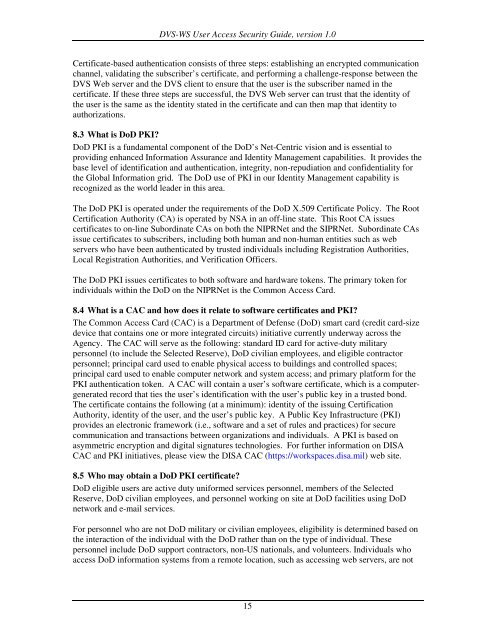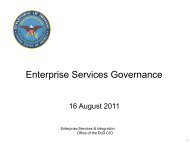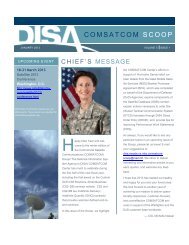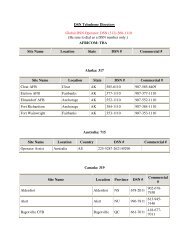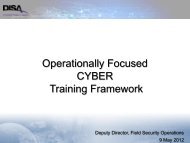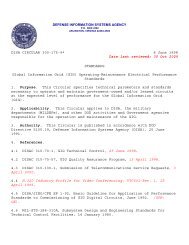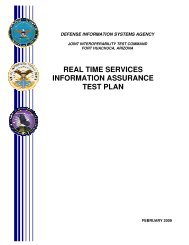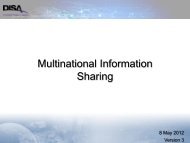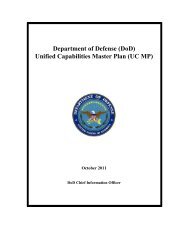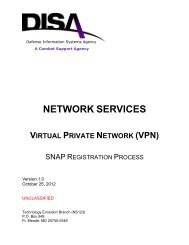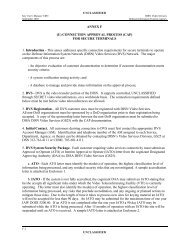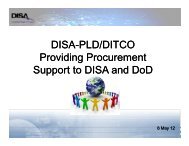Defense Information System Network (DISN) Video Services Web ...
Defense Information System Network (DISN) Video Services Web ...
Defense Information System Network (DISN) Video Services Web ...
You also want an ePaper? Increase the reach of your titles
YUMPU automatically turns print PDFs into web optimized ePapers that Google loves.
DVS-WS User Access Security Guide, version 1.0<br />
Certificate-based authentication consists of three steps: establishing an encrypted communication<br />
channel, validating the subscriber’s certificate, and performing a challenge-response between the<br />
DVS <strong>Web</strong> server and the DVS client to ensure that the user is the subscriber named in the<br />
certificate. If these three steps are successful, the DVS <strong>Web</strong> server can trust that the identity of<br />
the user is the same as the identity stated in the certificate and can then map that identity to<br />
authorizations.<br />
8.3 What is DoD PKI?<br />
DoD PKI is a fundamental component of the DoD’s Net-Centric vision and is essential to<br />
providing enhanced <strong>Information</strong> Assurance and Identity Management capabilities. It provides the<br />
base level of identification and authentication, integrity, non-repudiation and confidentiality for<br />
the Global <strong>Information</strong> grid. The DoD use of PKI in our Identity Management capability is<br />
recognized as the world leader in this area.<br />
The DoD PKI is operated under the requirements of the DoD X.509 Certificate Policy. The Root<br />
Certification Authority (CA) is operated by NSA in an off-line state. This Root CA issues<br />
certificates to on-line Subordinate CAs on both the NIPRNet and the SIPRNet. Subordinate CAs<br />
issue certificates to subscribers, including both human and non-human entities such as web<br />
servers who have been authenticated by trusted individuals including Registration Authorities,<br />
Local Registration Authorities, and Verification Officers.<br />
The DoD PKI issues certificates to both software and hardware tokens. The primary token for<br />
individuals within the DoD on the NIPRNet is the Common Access Card.<br />
8.4 What is a CAC and how does it relate to software certificates and PKI?<br />
The Common Access Card (CAC) is a Department of <strong>Defense</strong> (DoD) smart card (credit card-size<br />
device that contains one or more integrated circuits) initiative currently underway across the<br />
Agency. The CAC will serve as the following: standard ID card for active-duty military<br />
personnel (to include the Selected Reserve), DoD civilian employees, and eligible contractor<br />
personnel; principal card used to enable physical access to buildings and controlled spaces;<br />
principal card used to enable computer network and system access; and primary platform for the<br />
PKI authentication token. A CAC will contain a user’s software certificate, which is a computergenerated<br />
record that ties the user’s identification with the user’s public key in a trusted bond.<br />
The certificate contains the following (at a minimum): identity of the issuing Certification<br />
Authority, identity of the user, and the user’s public key. A Public Key Infrastructure (PKI)<br />
provides an electronic framework (i.e., software and a set of rules and practices) for secure<br />
communication and transactions between organizations and individuals. A PKI is based on<br />
asymmetric encryption and digital signatures technologies. For further information on DISA<br />
CAC and PKI initiatives, please view the DISA CAC (https://workspaces.disa.mil) web site.<br />
8.5 Who may obtain a DoD PKI certificate?<br />
DoD eligible users are active duty uniformed services personnel, members of the Selected<br />
Reserve, DoD civilian employees, and personnel working on site at DoD facilities using DoD<br />
network and e-mail services.<br />
For personnel who are not DoD military or civilian employees, eligibility is determined based on<br />
the interaction of the individual with the DoD rather than on the type of individual. These<br />
personnel include DoD support contractors, non-US nationals, and volunteers. Individuals who<br />
access DoD information systems from a remote location, such as accessing web servers, are not<br />
15


